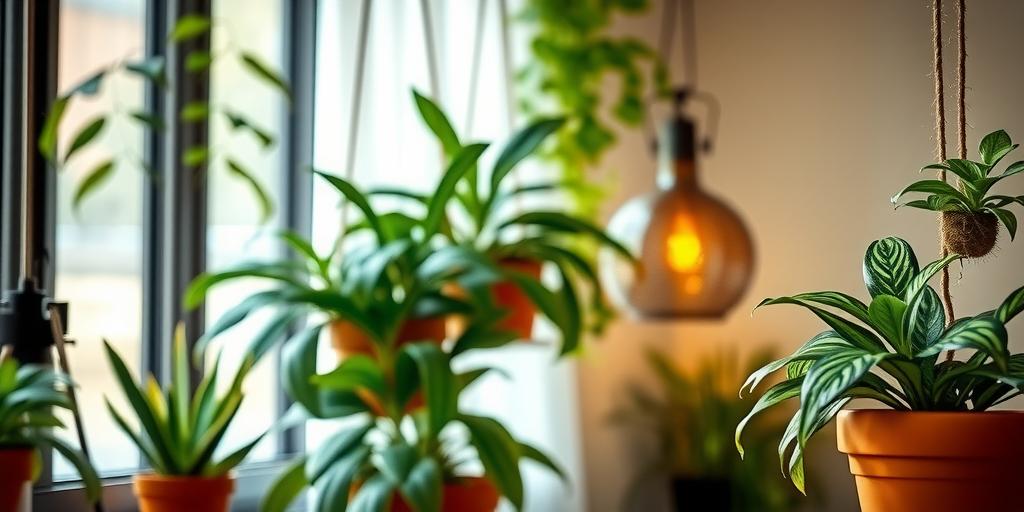
Essential Care Tips for Low Light Hanging Plants in Offices
Discover the best care tips for low light hanging plants in offices! Learn how to choose, water, and maintain thriving plants even in dim workspaces. Perfect for busy professionals.
Introduction
Did you know that adding hanging plants to your office can boost productivity by up to 15%? Even in low light, these green companions can thrive—if you know how to care for them properly. Whether you’re a busy professional or a plant newbie, this guide will help you keep your office greenery lush and vibrant. Let’s dive into the secrets of low light hanging plant care!
Best Low Light Hanging Plants for Offices
Pothos (Devil’s Ivy)
Pothos is one of the most forgiving plants you can choose for an office setting. It thrives in low light and can even survive under fluorescent lighting if natural light is scarce. Its heart-shaped leaves come in various shades, from deep green to variegated yellow and white. Plus, it’s a fast grower, so you’ll see those beautiful vines trailing down in no time. If you forget to water it occasionally, don’t worry—it bounces back quickly.
Spider Plant
If you’re looking for a plant that’s both stylish and functional, the spider plant is a fantastic choice. It’s known for its air-purifying qualities, removing toxins like formaldehyde from the air. Spider plants produce long, arching leaves and tiny “pups” that dangle from the mother plant, adding visual interest. They do well in indirect light and prefer slightly moist soil, making them easy to care for in an office environment.
Philodendron Heartleaf
The heartleaf philodendron is another excellent low-light option with lush, trailing vines that add a touch of greenery to any workspace. It’s incredibly low-maintenance—just water when the top inch of soil feels dry. This plant is also forgiving if you forget to water it occasionally, making it perfect for busy office settings. Its deep green, heart-shaped leaves bring a calming, natural aesthetic to desks or hanging planters.
ZZ Plant
The ZZ plant is practically indestructible, making it ideal for offices with minimal natural light. It thrives in low-light conditions and can go weeks without water, thanks to its thick, waxy leaves that store moisture. If your office has dim corners or areas far from windows, the ZZ plant will still flourish. Just be sure not to overwater it, as it’s prone to root rot in soggy soil.
Peperomia
For smaller office spaces, peperomia is a compact and charming choice. Its thick, fleshy leaves retain water, meaning it doesn’t need frequent watering. Peperomias come in various textures and colors, from deep green to variegated patterns, adding a pop of interest to your workspace. They do well in low to moderate light, making them versatile for different office setups.
How to Water Low Light Hanging Plants Correctly
Check Soil Moisture Before Watering
One of the biggest mistakes with low-light plants is overwatering. Since these plants receive less light, they don’t dry out as quickly as those in bright conditions. Before watering, stick your finger about an inch into the soil—if it feels dry, it’s time to water. If it’s still moist, hold off for a few more days.
Use Room-Temperature Water
Cold water can shock the roots, especially in office environments where temperatures may fluctuate. Always use room-temperature water to keep your plants happy. If possible, let tap water sit out overnight to allow chlorine to evaporate before using it on your plants.
Water Less Frequently in Low Light
Because low-light plants grow more slowly, they don’t need as much water as those in bright spaces. Overwatering can lead to root rot, which is a common killer of office plants. A good rule of thumb is to water less often but thoroughly—ensure water drains out the bottom of the pot to prevent soggy soil.
Ensure Proper Drainage
Hanging planters should always have drainage holes to allow excess water to escape. If your decorative pot doesn’t have holes, consider using a plastic nursery pot inside it or adding a layer of gravel at the bottom to improve drainage. This prevents water from pooling at the roots, which can cause rot.
Ideal Placement for Low Light Hanging Plants
Near North-Facing Windows
North-facing windows provide gentle, indirect light, which is perfect for low-light plants. If your office has one, hanging your plants nearby will give them enough brightness without the risk of scorching their leaves. Just make sure they’re not pressed right against the glass, as drafts can be harmful.
Away from Direct Sunlight
While some plants tolerate direct sun, most low-light varieties prefer shade. If your office has south or west-facing windows, keep your hanging plants a few feet away to avoid leaf burn. Sheer curtains can also help diffuse harsh sunlight while still letting in enough brightness.
In Corners or Shelves
Offices often have dim corners or shelves that don’t get much natural light—perfect spots for low-light hanging plants. Spider plants, pothos, and philodendrons can thrive in these areas, adding life to otherwise dull spaces. Just be sure to dust their leaves occasionally to maximize light absorption.
Rotate Plants Occasionally
Since low-light plants grow toward the light source, rotating them every few weeks ensures even growth. This prevents one side from becoming leggy while the other remains sparse. A simple quarter-turn every time you water can make a big difference in maintaining a balanced, full appearance.
Common Problems and Solutions for Low Light Hanging Plants
Yellowing Leaves
If your plant’s leaves are turning yellow, overwatering is likely the culprit. Check the soil—if it’s soggy, let it dry out completely before watering again. Trim any yellow leaves to encourage new growth. If the problem persists, consider repotting with fresh, well-draining soil.
Leggy Growth
Leggy, stretched-out stems usually mean your plant isn’t getting enough light. While low-light plants tolerate shade, they still need some brightness to stay compact. Move the plant slightly closer to a light source or supplement with an artificial grow light if natural light is extremely limited.
Pests Like Spider Mites
Spider mites and mealybugs can be a nuisance, especially in dry office environments. If you notice tiny webs or white cotton-like spots, wipe the leaves with a damp cloth and treat them with neem oil or insecticidal soap. Keeping humidity levels up (with a small humidifier or occasional misting) can also deter pests.
Slow Growth
If your plant seems stagnant, it might need a nutrient boost. Use a diluted liquid fertilizer every 2-3 months during the growing season (spring and summer). Avoid over-fertilizing, as this can harm the roots. If growth remains sluggish, reassess light conditions—sometimes a small adjustment can make a big difference.
Conclusion
Caring for low light hanging plants in your office doesn’t have to be tricky! By choosing the right plants, watering wisely, and placing them strategically, you can enjoy a greener, more vibrant workspace. Ready to transform your office into a plant paradise? Start with one of our recommended varieties and watch your space come to life!
